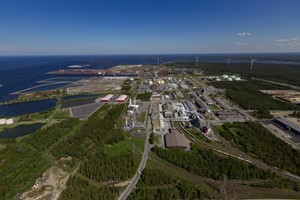News
Flexens and KIP to develop Finland’s largest H2 plant planned in Kokkola
Project developer Flexens Oy Ab and KIP Infra Oy, part of Kokkola city council, have signed a letter of intent regarding a land lease agreement for a facility with a H2 production capacity of approximately 300 megawatts (MW) in the Kokkola Industrial Park area. Such a facility would certify a strengthened energy and ammonia self-sufficiency for Finland. Production of mainly green H2 and ammonia is meant to start running at the end of 2027. The Finnish Minister of Economic Affairs, Mika Lintilä, considers this good news for both Central Ostrobothnia and the development of the Finnish H2 economy.
As the country’s largest H2 project to date, the facility in Kokkola would mark a concrete step forward for the Finnish H2 industry. The facility would also be partially responsible for Europe’s energy needs and ensure self-sufficient fertilizer production.
“The market outlook for green H2 and ammonia is excellent. BotHH2nia, the H2 Bay of the North, being established around the Gulf and Bay of Bothnia, is predicted to be able to meet a significant part of all of Europe's energy needs in the form of H2. Furthermore, the Kokkola plant's 300 MW would fulfil a third of the domestic capacity target of 1,000 MW as stated in Finland's climate and energy strategy,” said Berndt Schalin, CEO, Flexens Oy Ab.
“These are very happy news for Central Ostrobothnia and the development of the Finnish H2 economy. Thanks to the city's deep-water port and industrial center, Kokkola is a very attractive investment destination. Interest in producing green H2 and ammonia has increased enormously in recent years. Implementing this project would improve energy self-sufficiency and strengthen domestic fertilizer production for agriculture,” said Minister of Economic Affairs Mika Lintilä.
“H2 plays an important role in achieving the carbon neutrality goals set out in Finland’s climate and energy strategy. In addition, H2 production creates significant export-promoting opportunities and attracts investment and added value to Finland. A society with a completely renewable energy system requires wind and solar power, which vary according to weather. H2 can act as energy storage, and by being refined into ammonia needed for agriculture will in turn guarantee self-sufficiency,” Schalin commented.
Kokkola’s industrial park offers an excellent environment for H2 production
The new H2 plant is being built in the Kokkola Industrial Park. Kokkola was chosen because of the city’s suitable industrial area.
“H2 gas is already produced in Kokkola, which guarantees an established safe operating environment. In addition, there is a port in the area. Along the west coast, a type of H2 hub is also being formed, as there is already the wind power and green electricity required for H2 production,” said Schalin.
“The project implementation would strengthen the energy networks in Kokkola's large industrial area, such as the electricity and heating networks. This enables a significant waste heat recovery and brings us both employment opportunities and turnover. The project also supports the goals of our low-carbon strategy by, for example, reducing district heating and logistics emissions and enabling H2 and H2-based fuels in the area. Within the project, we are at least negotiating the construction of energy infrastructure and the possibilities of, among other things, recycling waste heat. We are open to various business models and new ideas,” Mikko Rintamäki, CEO, Kokkolan Energia Oy.
The H2 transmission infrastructure project nordic H2 route bothnian bay supports the development of the area’s H2 economy
One of the essential partners in the Kokkola H2 plant project is Gasgrid Finland, developing infrastructure for H2 transmission within the Nordic H2 Route Bothnian Bay project, together with the Swedish company Nordion Energi. The Nordic H2 Route Bothnian Bay project aims to set up a 1,000-kilometer H2 transmission network around the Bothnian Bay and Bothnian Gulf, and an open H2 market by 2030.
The H2 production facility and the Nordic H2 Route Bothnian Bay are important to each other and the green industrialization of the region, as they can contribute to the development of the H2 economy both in the Kokkola region and elsewhere. The H2 produced in the Kokkola plant can be transported and stored in the H2 transmission network developed in the area, to which several producers and consumers can connect. In this way, the conditions are created for H2 trading and the development of a H2 infrastructure and market.


